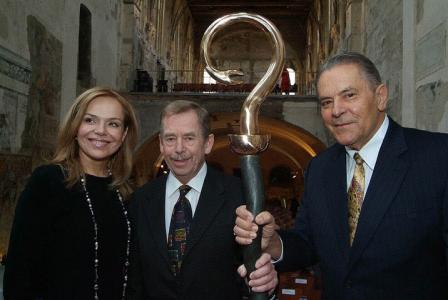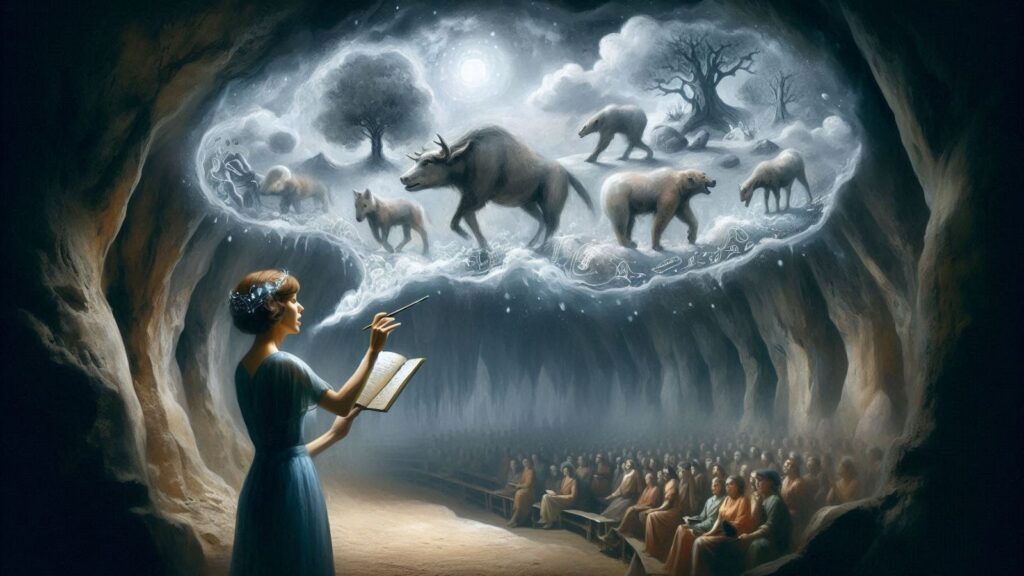Stanislav Grof, M.D., renowned researcher into non-ordinary states of consciousness, was honored as this year's recipient of the Vision 97 Award at a ceremony in Prague. Below is a description of the award, in the words of its founder, former Czech President Václav Havel, followed by Doctor Grof's acceptance speech:
Vision Award
To thinkers whose scientific work returns science into the framework of general culture, transcends the dominant concepts of knowledge and being, reveals unknown, surprising, or overlooked connections, and touches in a new way the mysteries of the universe and of life. It is thus an Award by which we would like to bring the attention of the public to spiritual achievements, which in the best sense of the word do not meet the criteria of the established ways of exploring of reality.
Dear Mrs. Havel, dear President Havel, ladies and gentlemen,
It is a great pleasure for me to return to Prague, where I was born, spent my childhood, grew up, and received my basic training. An even greater source of pleasure than my visit to this city that I love so much are the extraordinary circumstances that brought me to Prague this time. I would like to thank wholeheartedly President Havel, Mrs. Havel, and the board of consultants of the Dagmar and Václav Havel Foundation for granting me the prestigious Vision 97 Award for my work in the area of research of consciousness and the human psyche. It is for me an immense honor and also a great surprise after fifty years of struggle with the “public anonym” in science, described in such an articulate way by professor Vopenka in his 2004 acceptance speech, after he himself received the Vision 97 Award.
An important reason why the Vision 97 Award means so much to me is my profound admiration and respect for President Havel as an artist, philosopher, and statesman with a broad spiritual vision, and as a man of extraordinary personal values. My admiration is shared by many of my American friends, who have repeatedly expressed to me their wish to have in the present difficult situation a president with the intellectual, moral, and spiritual qualities of Václav Havel. And during my journeys to different countries, I have often had the opportunity to find out that similar feelings are shared by many people all over the world. I cannot imagine another appreciation of my work that would be for me personally more meaningful. Today’s ceremony falls on President Havel’s birthday, and I would like to use this opportunity to congratulate him on this important anniversary and wish him much happiness, inner peace, personal satisfaction, and good health in the years to come.
It seems to be my destiny – or karma, if you wish – to be involved in research of areas that are subjects of great controversy in science and society. My unconventional professional career started here in Prague more than fifty years ago when I volunteered as a beginning psychiatrist for a session with LSD-25, diethylamide of lysergic acid. My preceptor, Docent Roubicek, received this fascinating experimental substance from the Swiss pharmaceutical company Sandoz. The incredibly powerful psychedelic effects of this ergot alkaloid had been discovered by Dr. Albert Hofmann, who accidentally intoxicated himself while working on its synthesis.
The research project of Docent Roubicek required a combination of the pharmacological effect of LSD with exposure to a powerful stroboscopic light oscillating at various frequencies. This combination evoked in me a powerful mystical experience that has radically changed my personal and professional life. It had such a profound effect on me that research of the heuristic, therapeutic, transformative, and evolutionary potential of non-ordinary states of consciousness has become my profession, vocation, and personal passion for the rest of my life.
During approximately half of this period, my interest focused on clinical research of psychedelic substances, first at the Psychiatric Research Institute in Prague-Bohnice and later at the Maryland Psychiatric Research Center in Baltimore where I headed for several years the last surviving official psychedelic research in the United States. During the second half of this period, my wife Christina and I developed jointly the method of holotropic breathwork, which induces deep non-ordinary states of consciousness with the use of very simple means, such as accelerated breathing, evocative music, and a certain kind of bodywork. Over the years, we have also worked with many people undergoing spontaneous episodes of non-ordinary states of consciousness – psychospiritual crises or “spiritual emergencies” as we call them.
Research of non-ordinary states of consciousness (or their important subgroup, for which I coined the term “holotropic”) has been for me a source of countless surprises and conceptual shocks, requiring radical changes in understanding consciousness, the human psyche, and the nature of reality. After many years of daily encounters with “anomalous phenomena,” which contemporary science was unable to explain and the existence of which was in conflict with its fundamental metaphysical assumptions, I came to the conclusion that careful study of holotropic states and various phenomena which are associated with them, such as statistically highly improbable meaningful coincidences (Jung’s “synchronicities”), shows the inevitability of a radical revision of thinking in psychology and psychiatry.
Conceptual changes required in these disciplines would in their nature, depth, and scope resemble the revolution which the physicists experienced in the first three decades of the twentieth century, when they had to move from Newtonian mechanics to theories of relativity and later to quantum physics. It is even possible to say that, in a certain sense, this conceptual revolution would be a logical completion of the radical changes which many years ago already occurred in physics.
The changes in the understanding of consciousness and of the human psyche in health and disease that naturally follow from the research of holotropic states fall into several categories. This research has shown the necessity to expand the traditional model of the psyche, limited to postnatal biography and the Freudian individual unconscious by two vast areas – perinatal (which has a close connection with the memories of biological birth) and transpersonal (mediating experiences of identification with other people, animals, and the botanical realm and with human and animal ancestors, as well as experiences of the historical and archetypal collective unconscious, as described by C. G. Jung). Traditional psychiatry sees the beginnings of “psychogenic” disorders – those that do not have any demonstrable biological causes – in infancy and childhood. The work with holotropic states shows clearly that these disorders have additional deep roots in the perinatal and transpersonal realms of the unconscious. This finding might seem in and of itself very pessimistic, but it is outweighed by the discovery of new effective therapeutic mechanisms which operate on these deep levels of the unconscious.
The goal in traditional psychotherapies is to reach an intellectual understanding of how the human psyche functions – what are its basic motivating forces, why do symptoms develop and what is their meaning. This understanding then forms the basis for the development of techniques that psychotherapists use for the treatment of their clients. A serious problem associated with this strategy is a striking lack of agreement among psychologists and psychiatrists concerning the most fundamental theoretical problems and, consequently, an astonishing number of competing schools of psychotherapy. The work with holotropic states offers a surprising radical alternative – mobilization of deep inner healing intelligence of the clients that is capable to govern the process of healing and transformation.
Materialistic science does not have a place for any form of spirituality and considers it to be essentially incompatible with the scientific worldview. It perceives any form of spirituality as an indication of lack of education, superstition, gullibility, primitive magical thinking, or a serious psychopathological condition. Modern consciousness research shows that spirituality is a natural and legitimate dimension of the human psyche and of the universal order of things. However, it is important to emphasize that this statement refers to direct authentic spirituality based on personal experience and not to the ideology and dogmas of organized religions.
New observations show that consciousness is not an epiphenomenon of matter – a product of complex neurophysiological processes in the brain – but a fundamental primary attribute of existence, as it is described in the great spiritual philosophies of the East. As suggested by the Swiss psychiatrist C. G. Jung, the psyche is not enclosed in the human skull and brain, but permeates all of existence (as anima mundi). The individual human psyche is an integral part of this cosmic matrix and can under certain circumstances experientially identify with its various aspects.
This new understanding of the human psyche has important sociopolitical implications. Medical anthropologists have shown that the striking physical differences between various human groups disappear when the scientific research of homo sapiens penetrates the thin layers of the epidermis; the basic anatomical, physiological, and biochemical characteristics are shared by all of humanity. Modern consciousness research complemented this observation by similar findings related to the human psyche. On the postnatal biographical level exist large individual and cultural differences; the conditions of life differ radically from person to person from family to family, and from culture to culture. However, these differences begin to disappear as soon as experiential self-exploration in holotropic states of consciousness reaches the perinatal level. All members of the human species share the experiences of prenatal life and birth; the differences in this area are interindividual rather than specific for various racial groups. And when the process of deep experiential probing reaches the transpersonal level, all differences disappear,
Our observations have shown that people from all human groups with whom Christina and I have worked in various parts of the world – in Europe; India; Japan; Taiwan; Australia; South, Central, and North America; Australia; and Polynesia – had in their holotropic experiences access to the entire collective unconscious as described by C. G. Jung, both in its historical and archetypal-mythological realms, without regard to their own racial, national, and cultural background. These experiences have even frequently bridged gender differences; many karmic, ancestral, and racial experiences contained convincing identification with members of the opposite sex. Equally frequent were identifications with representatives of other animal species. Observations of this kind provide strong evidence for something that traditional materialistic scientists would consider impossible and utterly absurd – that the entire history of humanity and life on this planet are permanently recorded in an immaterial field to which each of us has under certain circumstances experiential access. The Hungarian/Italian system theorist Ervin Laszlo has been able to define scientifically such a field and gave it the name the “psi field"; more recently, he renamed it as the “akashic field” by linking it explicitly to the spiritual traditions.
Perinatal and transpersonal experiences have profound psychological implications. When the content of the perinatal level of the unconscious surfaces into consciousness and is adequately processed and integrated, it results in a radical personality change. The individual experiences a considerable decrease of aggressive tendencies and becomes more tolerant and compassionate toward others. The experience of psychospiritual death and rebirth and conscious connection with positive postnatal and prenatal memories reduces irrational ambitions and urges and increases élan vital and joi d'vivre – the ability to enjoy life and draw satisfaction from simple situations such as everyday activity, eating, love-making, nature, and music.
The process of spiritual opening and transformation typically deepens further as a result of transpersonal experiences. Feelings of oneness with the universe and its creative principle lead to identification with all sentient beings and bring a sense of awe, wonder, love, compassion, and inner peace. Spirituality that results from this process is universal, all-encompassing, transcending all organized religions; it resembles the attitude to the Cosmos found in the mystics of all ages. It is extremely authentic and convincing, because it is based on deep personal experience. It is therefore capable to compete successfully with the dogmas of organized religions, as well as the monistic-materialistic worldview of Western science.
People who are experientially connected with the transpersonal dimensions have a tendency to appreciate existence and feel reverence for all creation. One of the most remarkable consequences of various forms of transpersonal experience is the spontaneous emergence and development of genuine humanitarian and ecological interests, and the need to take part in activities aimed at peaceful coexistence and well-being of humanity. This is based on an almost cellular understanding that any boundaries in the Cosmos are relative and arbitrary, and that each of us is, in the last analysis, identical and commeasurable with the entire fabric of existence. As a result of these experiences, individuals tend to develop feelings that they are planetary citizens and members of the human family before belonging to a particular country or a specific racial, social, ideological, political, or religious group. It seems obvious that transformation of this kind could significantly increase our chances of survival if it could occur on a sufficiently large scale.
It seems that we are involved in a dramatic race for time which has no parallel in human history. What is at stake is nothing less than the future of humanity and the fate of life on our planet. If we continue using the old strategies that have caused the current global crisis, and which are in their consequences destructive and self-destructive, it might lead to annihilation of modern civilization and possibly even the human species. However, if a sufficient number of people undergoes a process of inner psychospiritual transformation and attain a higher level of awareness, we might in the future reach a situation where we will deserve the name which we have so proudly given to our species: Homo sapiens sapiens.
In closing I would like to express my deep gratitude to Christina, my wife, best friend, and co-worker for everything that she contributed over the years to the research, which has today received such an extraordinary appreciation.
For more information, visit Stanislav Grof's website at http://stanislavgrof.com/index.htm.















